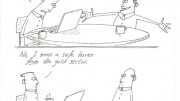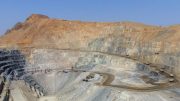Innovation has become a hot topic in the mining industry once again. A report on the current state of innovation, by the Prospectors & Developers Association of Canada (PDAC) and Monitor Deloitte, is due out in the next few weeks. In April the Canadian Institute of Mining, Metallurgy and Petroleum invited Nathan Stubina, managing director of McEwen Mining, to speak at a luncheon on the subject. And of course, consultancies such as Deloitte and PwC have been warning for years that the industry needs fundamental change to survive.
This focus comes, ironically, after a decade or more of major companies slashing their capacity for research and development, as well as exploration spending.
Certainly, there are many examples of innovative ideas and technologies in the mining sector, including automated mining at several Rio Tinto iron ore mines in the Pilbara region of Western Australia and BHP Billiton’s Jansen potash project in Saskatchewan, where tunnelling machinery has been adapted to sink two 1,000-metre shafts. On the exploration side, Shawn Ryan’s GroundTruth Exploration is using UAV drones to gather high-resolution imagery cheaply in challenging terrain.
However, it’s widely acknowledged that overall, the industry does poorly on innovation. Part of this is because of a lack of investment, Anglo American CEO Mark Cutifani told Mining Technology.com last year, with the mining sector spending 10% of the amount the oil and gas sector spends on R&D. But part of it is also the industry’s mindset. Mining is a conservative industry, and while companies are exposed to political, commodity price and other types of risk, they see innovation as risky, the PDAC and Deloitte survey found.
Miners also feel their business is different from other sectors. So while industries such as manufacturing, telecommunications, automotive and aerospace have transformed themselves using ideas and technologies borrowed from other fields, and vastly increasing productivity, miners have been reluctant to do the same.
At a recent presentation by Monitor Deloitte and PDAC on innovation, one mining sector executive said that borrowing such ideas and technology is “low-hanging fruit.” Nonetheless, he acknowledged such fruit is hard to reach because of the culture of mining companies. “We don’t need to reinvent the wheel … but how do you change the culture of the mining organizations? That’s where leadership comes in.”
So far, leadership has largely given investors what they say they want — which is cash in the form of dividends.
But what if companies cut their dividends in order to invest in innovative projects, with a good chance of creating real returns, asked Deloitte chair Glenn Ives.
“Right now, my observation would be that the reason investors are asking for dividends back from the industry is they’re not convinced the industry can use the money wisely,” Ives said.
Going back as far as a 1985 MacDonald Royal Commission report on Canada’s economic prospects, it’s been suggested that the mining sector not only needs to invest in innovation in mining and exploration technologies, but also in research on new applications and markets for its products.
While that may sound far-fetched in the current environment — where miners are struggling with rising costs, declining grades and commodity prices, and increased demands by stakeholders and shareholders — isn’t it what Google would do if it was in the mining business?
Although the task is daunting for an industry that is used to high commodity prices saving the day, the news isn’t all bad. Research has shown that, in any industry, it’s not the companies that spend the most on innovation that are the most innovative.
A recent PwC UK study showed that while Apple, Google and Amazon are seen as the most innovative companies, they don’t spend the most on R&D. (Healthcare and pharma companies have some of the biggest R&D budgets.)
“What many highly innovative companies have in common is not a high level of R&D spending, but an understanding of end users’ wants and needs,” partner with PwC firm Strategy& Jens Nackmayr said. “Instead of depending on market research, these companies form strong connections with customers and innovate around their yet-to-be articulated needs.”
How does that apply to the mining sector?
Miners may risk losing even more investor interest if they don’t try to figure it out.
Or it could be worse, Anglo’s Cutifani warned last year: “If we don’t start to bring innovation back … the major diversifieds will be subsidiaries of General Electric, or some other conglomerate that has still got innovation in their vocabulary.”



This article is very revealing and to the point. The statement that “Mineral Industry is different to other industries” is a hard fact not appreciated and understood by many and particularly Govts;Mineral are site specific,finite and non renewable; so I am convinced that the business model has to be different.
Rao,T.C.